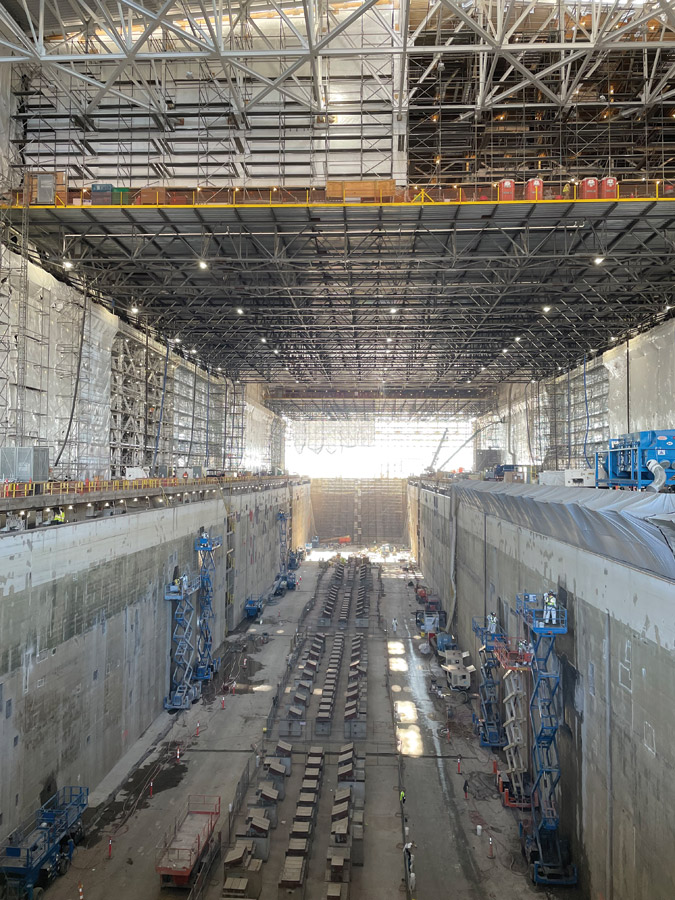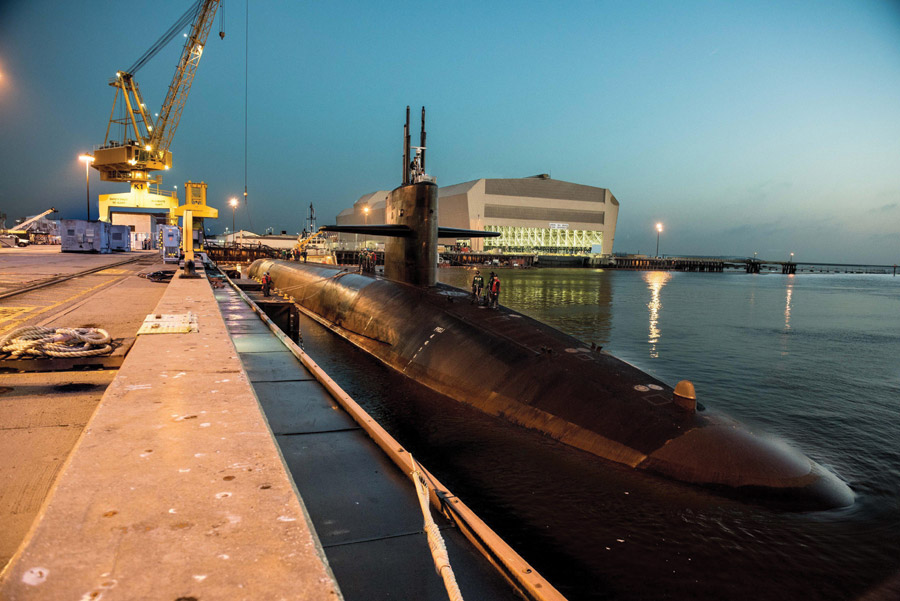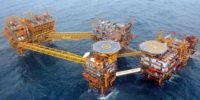Kings Bay Dry Dock Recapitalization
St. Marys, Ga.
Project of the Year Finalist
Submitted By: Alberici-Mortenson, a Joint Venture
Region: ENR Southeast
Owner: Naval Facilities Engineering Command (NAVFAC) Southeast
Lead Design Firm: Burns & McDonnell
General Contractor: Alberici-Mortenson, a Joint Venture
Engineer of Record/Caisson and Substructure: Moffatt & Nichol
Subcontractors: Crowder Industrial Construction LLC; Sachs Electric Co.; Kienlen Constructors; Boston Ship Repair LLC; Structural Preservation Systems LLC; BRK Electrical Contractors LLC; Crown Corr Inc.; C. A. Murren & Sons Heavy Civil LLC; Pollock Research & Design Inc., dba Reading Crane & Engineering Co.; Sustainable Modular Management; Nidec Motor Corp., dba Nidec Industrial Solutions; Kolb Grading LLC; Allen & Graham Inc.; Schoellhorn-Albrecht Machine Co.; F. D. Thomas Inc.: Oracle Elevator Holdco Inc. dba Oracle Elevator; Legacy Building Solutions Inc.; Crane 1 Services Inc.; Black Security Products LLC; McAllister Towing of New York LLC; Federal EC LLC; Contech Engineered Solutions LLC; FireTech LLC; U.S. Chemical Storage LLC; Precision Environments Inc.; Ballard Marine Construction LLC; Coffman Engineers Inc.; High Purity Systems Inc.; Inspired Solutions Inc.; Black & Decker (U.S.) Inc. dba SWS VidmarLista; Leonard Masonry Acquisition LLC dba Leonard Masonry; BD Landscaping and Irrigation LLC; RedGuard LLC; Sabre Industries Inc.; National Construction Rentals Inc.; Hampton Roads Marine Services Inc. dba Coastal Services; Investment Engineering dba Sparhawk Group; Boykin Erectors Inc.; Forms & Supply Inc dba FSI Office; Mathand Inc.; CID Associates Inc.; Complete Mobile Home Setup Inc.; Southern Valve & Metals LLC; Flexible Lifeline Systems Inc.; Astro Pak Corporation; Mueller Water Products Inc. dba Henry Pratt Company LLC; Cross Environmental Services Inc.; Kudzue 3 Trucking Inc.; Spring Precast LLC; Diverzify Holdings LLC dba Diverzify+ LLC; Actalent Inc.; Translift Dock & Door LLC; Industrial Door Contractors Inc.; On Target Technologies Inc.; First Coast Test and Balance Inc.; Evan Corporation dba Evan Fall Protection; Peachtree Service Inc. dba Peachtree Pest Control; Eddy's Glass and Mirror LLC; J. Greene Enterprise dba First Coast Fire and Safety Equipment; Kendell Intermediate Corporation dba Kendell Doors & Hardware LLC; Wagner Consulting Group Inc.; Dixie Contract Carpet, Inc.; Ochoa Construction LLC; Donco Inc.; Multi-graphics Inc.
Kings Bay naval base, on the Georgia-Florida border, has been the U.S. Navy hub for nuclear ballistic missile submarines since the 1980s, says the team submission, with its 700-ft-long by 100-ft-wide by 67-ft-deep Trident Refit Facility drydock in near continuous use since. “As one of the largest dry docks in the Northern Hemisphere, [it] has been and continues to be critical to supporting the operational cycle of our Ohio-class submarines,” said Rear Adm. Thomas R. Buchanan, commander of Submarine Group Ten.
But time caught up with the facility. Operating complex mechanical and electrical systems specific to nuclear submarines that are 40 years-old and with spare parts difficult to obtain, “failures and breakdowns were happening routinely, impacting the ability to do maintenance,” said U.S. Navy Cmdr. Marcel T. Duplantier, who led the estimated $625-million overhaul for the Naval Facilities Engineering Command Southeast and recently retired. He noted a previous switchgear fire that reduced system redundancy, with the base “essentially limping along with fingers crossed for several years until we replaced it.”
Despite the upgrade effort needed, a first-ever operations pause for critical construction to prepare the base for larger and more complex submarines that are set to arrive as early as 2027, did not come easily.
The team sought a 24-month shutdown, with the Navy wanting half that, said Duplantier, a 21-year veteran. It finally agreed to a 15-month closure. “There were very few people in the Navy who believed we were going to get this done on time,” he said. “Schedule extension … would mean more deferred submarine maintenance that was untenable” to service leaders, Duplantier added.
Terming the project one of the largest government investments in naval infrastructure since World War II, the team said its scope included electrical system overhaul, complete mechanical replacements, significant concrete repair inside the dry dock basin, steel structural upgrades across the facility and overhaul of two 85-ton bridge cranes.
The shutdown phase of construction was completed on time in September 2022, with all work wrapped up on budget last April, the team said.


Contractor Alberici-Mortenson developed elevated work platforms (top) to speed superstructure and system work at Kings Bay, in the key U.S. nuclear submarine port's first-ever large overhaul.
Photos: Alberici Constructors Inc., top, AB Forces News Collection/Alamy, bottom
Expediting Work
That work was performed 24/7, involving two shifts and a “significant portion performed from extreme heights,” said the submission, with the team erecting a 2.2-sq-acre movable work platform that enabled simultaneous construction on the superstructure and substructure. An Alberici unit fabricated the work deck, with the parent firm self-performing 42% of the project scope, said the submission. Crews replaced 19,000 linear ft of mechanical piping.
A key focus of work was the facility’s dry dock caisson, a 120-ft-long, 62-ft-tall and 20-ft-wide steel structure that enables “in the dry” repairs. It was pumped dry and towed 1,173 miles to Boston, where Alberici-Mortenson replaced mechanical, electrical and plumbing systems and recoated it inside and out. Crews also replaced carbon-based pipe at the base with fiber-reinforced plastic pipe for most utility systems to prevent corrosion that occurs “at an astonishingly fast rate” in the coastal environment, and to extend system lifecycles, said Duplantier.
But project scope did not involve resilience upgrades, he added, noting that the original facility was built above the 100-year flood plain level “so we did not have storm surge or inundation concern.” It also was designed to withstand 150-mph hurricane wind speeds, he added. Upgrading the drydock control panel, the “brain” of the operations, said Duplantier, was most critical.
“Setting a multibillion dollar submarine on dry land is a carefully coordinated event,” he said, with panel reliability key to successful drydock flooding and dewatering.
A study of facility deficiencies by lead design firm Burns & McDonnell included 3D laser scanning of 900,000 sq ft, “which allowed for detailed modeling of the existing infrastructure and improved clash detection during design,” said lead project engineer Sean McGillis. Despite added security for scan equipment and careful collaboration with dry dock managers to avoid interrupting active work in confined spaces, the technology was ”highly effective” in boosting design accuracy and efficiency, he said.
To prevent bottlenecks, special security and site access rules were developed for up to 1,300 craft workers as well as streamlined communication protocols for critical information. A three-person “continuity cell” managed all RFIs, change orders and submittal reviews, said McGillis. Despite risks, the project reported no fatalities and a 0.18 lost time accident rate in 3.3 million work hours. The contractor noted its formation of a “crew-based safety advocate to create greater responsibility and involvement at all levels.”
But one schedule risk the team noted was its inability to detect degraded superstructure steel until the shutdown, when sandblasting exposed anomalies. Because the design did not include repairs, “we quickly assembled a cross-functional project team to solve the problem,” said Duplantier. This included intensive inspections, added NAVFAC resources and a contract modification, he said. “An all-hands-on-deck effort ended up working out beautifully in the end but was quite a heavy lift in the middle of an already complex project,“ he added. The team replaced 30,000 bolts and welded 31,000 linear ft of steel.
Despite what he termed a “me-first” culture on many projects, Duplantier said, on Kings Bay “we were able to consistently rebalance interactions to be project-first.”
He said process innovations on the project will set a standard for Navy upgrades under its multibillion-dollar Shipyard Infrastructure Optimization Program, set to repair and replace drydocks at four public shipyards. “It became a proving ground of sorts … for operating structures, risk management procedures and innovative contracting strategies,” Duplantier said.
"Replacement of antiquated systems with new has significantly improved operational reliability and reduced the requirement for corrective maintenance downtime, which in turn allows for improved focus on mission support," said Navy Cdr. Dan Cloutier, current director of the Kings Bay Public Works Facilities Engineering and Acquisition Division. "The ability to maintain submarines at Kings Bay at the rate required to support operations is critical to the Navy’s strategic deterrence mission."






Post a comment to this article
Report Abusive Comment